
- Home
- Travel Packages
- Top Destination
-
Travel Attraction
By Category
Top Attraction

- Travel Agents
- Car Rentals
- Hotels
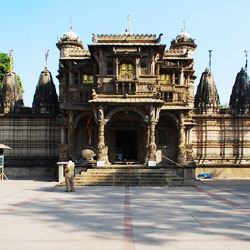
About Hatheesing Jain Temple History The Hatheesing Jain Temple in Ahmedabad, Gujarat was built in 1850 by a wealthy Jain merchant named Sheth Hathisinh Kesarisinh. The temple is dedicated to Dharmanath, the fifteenth Tirthankara of Jainism. It is known for its intricate architecture and stunning design, making it one of the most popular Jain temples in India. Architecture and Design The Hatheesing Jain Temple is a two-storied structure made entirely of white marble. The temple features 52 domes, each representing a different Jain Tirthankara. The interior of the temple is adorned with beautiful carvings and intricate designs, showcasing the skill and craftsmanship of the artisans who built it. Best Time to Visit The best time to visit the Hatheesing Jain Temple is during the winter months, from October to March, when the weather is cooler and more comfortable for exploring the temple and its surroundings. Cultural Significance The Hatheesing Jain Temple is an important religious site for the Jain community in Ahmedabad and beyond. It represents the rich cultural heritage of Jainism and serves as a place of worship and reflection for followers of the faith. Pilgrimage Practices Visitors to the Hatheesing Jain Temple are encouraged to observe the traditional practices of Jainism, such as meditation, prayer, and offering of flowers and incense to the deities. Pilgrims often perform rituals and ceremonies to seek blessings and spiritual guidance. Dress Code and Etiquette Visitors to the temple are required to dress modestly and respectfully, covering their shoulders and knees. Shoes must be removed before entering the temple premises, and photography is usually not allowed inside the prayer halls. It is important to maintain a quiet and respectful demeanor while inside the temple. Activities and Experiences Visitors to the Hatheesing Jain Temple can participate in guided tours, attend religious ceremonies, and explore the intricate architecture and design of the temple. Many visitors also take part in cultural programs and events held at the temple throughout the year. Art and Religious Symbols The Hatheesing Jain Temple is adorned with exquisite carvings, sculptures, and paintings that depict scenes from Jain mythology and history. The temple also features various religious symbols and motifs that hold significance for followers of Jainism. Local Insights Locals in Ahmedabad regard the Hatheesing Jain Temple as a symbol of the city's cultural and religious diversity. They take pride in the temple's architectural grandeur and its historical significance, welcoming visitors from all over the world to experience the beauty and tranquility of this sacred site.
Explore More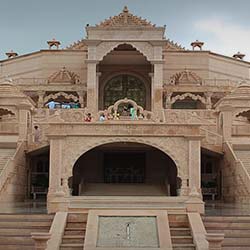
About Nareli Jain Temple, Ajmer The Nareli Jain Temple in Ajmer, Rajasthan is a magnificent architectural marvel that attracts numerous visitors and pilgrims from all over the country. This temple is dedicated to the Jain community and is known for its stunning design and religious significance. Let's delve into the history, architecture, and cultural practices associated with this iconic temple. History The construction of the Nareli Jain Temple began in the year 1997 under the guidance of the Anand Rishiji Maharaj. It took nearly 10 years to complete the temple complex, which is spread over 24 acres of land. The temple was built to provide a spiritual retreat for the Jain community and to showcase the rich cultural heritage of the religion. Architecture and Design The Nareli Jain Temple features a unique blend of modern and traditional architectural styles. The temple complex consists of 24 miniature temples, each dedicated to a different Jain Tirthankara. The central temple is adorned with intricate carvings, golden spires, and ornate domes, creating a mesmerizing sight for visitors. Best Time to Visit Visiting the Nareli Jain Temple in Ajmer is best during the winter months (October to March) when the weather is pleasant and ideal for sightseeing. Avoid visiting during the summer months (April to June) as the scorching heat can make it uncomfortable for outdoor activities. Cultural Significance The Nareli Jain Temple holds immense cultural significance for the Jain community as it serves as a place of worship, spiritual reflection, and community gatherings. Visitors can witness traditional Jain rituals, prayers, and ceremonies that are performed at the temple, offering a glimpse into the rich cultural heritage of the religion. Pilgrimage Practices Devotees visiting the Nareli Jain Temple often engage in various religious practices such as meditation, chanting of prayers, and offering of prayers to the deities. Pilgrims also participate in temple rituals, seek blessings from the priests, and make offerings to the Tirthankaras as a form of devotion and gratitude. Dress Code and Etiquette When visiting the Nareli Jain Temple, it is important to dress modestly and respectfully. Both men and women are expected to wear conservative clothing that covers their shoulders and knees. Remove footwear before entering the temple premises and maintain silence and decorum during prayer sessions. Activities and Experiences Visitors to the Nareli Jain Temple can participate in a range of activities and experiences that enrich their spiritual journey. Attend religious discourses, explore the temple complex, partake in religious ceremonies, and seek blessings from the deities. The serene surroundings and tranquil ambiance make it an ideal place for meditation and introspection. Art and Religious Symbols The Nareli Jain Temple is adorned with intricate sculptures, paintings, and carvings that depict scenes from Jain mythology and history. Religious symbols such as the Jain wheel, Swastika, and Om are prominently featured in the temple architecture, reflecting the spiritual beliefs and values of the Jain community. Local Insights Local residents of Ajmer can provide valuable insights into the history, cultural practices, and significance of the Nareli Jain Temple. Engage with local guides, priests, and artisans to gain a deeper understanding of the temple's architecture, religious rituals, and the influence of Jainism in the region.
Explore More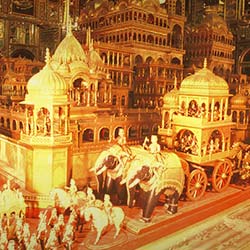
About Ajmer Jain Temple History, Architecture and Design The Ajmer Jain Temple, also known as Soniji Ki Nasiyan, is a stunning piece of architecture located in the city of Ajmer, Rajasthan. This temple was built in the late 19th century by the Jain merchant Seth Moolchand Soni. It is dedicated to Lord Rishabhanatha, who is considered to be the first Tirthankara of Jainism. The temple is known for its intricate designs and breathtaking architecture. The two-story structure is made entirely of red sandstone and features intricate carvings, sculptures, and paintings that depict various Jain philosophies and teachings. Best Time to Visit - The best time to visit the Ajmer Jain Temple is during the winter months, from October to March, when the weather is pleasant and perfect for exploring the temple and its surroundings. - The temple is also open throughout the year, so you can visit anytime you wish. Cultural Significance The Ajmer Jain Temple holds immense cultural significance for the Jain community. It is considered a sacred place of worship and pilgrimage for followers of Jainism. The temple is not only a religious site but also a cultural and historical landmark that showcases the rich heritage of Rajasthan. Pilgrimage Practices Visitors to the Ajmer Jain Temple can participate in various pilgrimage practices such as offering prayers, meditating, and performing rituals. Many devotees also bring offerings such as fruits, flowers, and sweets as a symbol of their devotion to Lord Rishabhanatha. Dress Code and Etiquette While visiting the Ajmer Jain Temple, it is important to dress modestly and respectfully. Visitors are required to cover their heads and remove their shoes before entering the temple premises. It is also considered polite to maintain silence and refrain from speaking loudly or engaging in disruptive behavior. Activities and Experiences Visitors to the Ajmer Jain Temple can engage in a variety of activities and experiences such as exploring the temple complex, admiring the intricate architecture, attending religious ceremonies, and learning about Jainism and its teachings. The temple also hosts various cultural events and festivals throughout the year that offer a glimpse into Jain traditions and practices. Art and Religious Symbols The Ajmer Jain Temple is adorned with beautiful artworks and religious symbols that hold deep spiritual significance for followers of Jainism. The temple's walls, ceilings, and pillars are adorned with intricate carvings, sculptures, and paintings that depict various Jain deities, symbols, and teachings. These artworks serve as a visual representation of Jain philosophy and spirituality. Local Insights Visiting the Ajmer Jain Temple offers visitors a unique opportunity to immerse themselves in the rich culture and heritage of Rajasthan. The temple is not only a place of worship but also a symbol of Jain traditions and values that have been passed down through generations. By exploring the temple and interacting with locals, visitors can gain valuable insights into the history, art, and spirituality of Jainism in the region.
Explore More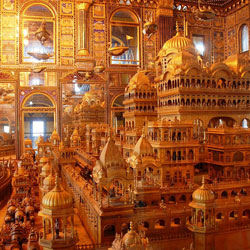
About Soniji Ki Nasiyan Soniji Ki Nasiyan, also known as the Ajmer Jain Temple, is a prominent religious site in Ajmer, Rajasthan, India. It is dedicated to Lord Rishabhanatha, who is the first Tirthankara of Jainism. The temple is renowned for its stunning architecture and intricate design, making it a must-visit attraction for tourists and pilgrims alike. History, Architecture, and Design The construction of Soniji Ki Nasiyan began in the late 19th century and was completed in 1865. The temple is adorned with intricate carvings, sculptures, and paintings that depict various Jain legends and teachings. The main prayer hall, known as the Swarna Nagari (City of Gold), is a marvel of architecture with its ornate gold-plated wooden structures and beautiful glasswork. Best Time to Visit - The best time to visit Soniji Ki Nasiyan is during the winter months from October to March when the weather is pleasant. - It is recommended to avoid visiting during the monsoon season from July to September due to heavy rainfall. Cultural Significance Soniji Ki Nasiyan holds great cultural significance for the Jain community as it is a place of worship and spiritual enlightenment. The temple is a symbol of Jain values such as non-violence, truthfulness, and compassion. Pilgrimage Practices Pilgrims visiting Soniji Ki Nasiyan usually participate in prayer ceremonies, offer donations, and seek blessings from the deities. It is a common practice to perform rituals such as lighting incense sticks, offering flowers, and chanting prayers. Dress Code and Etiquette Visitors are required to dress modestly and cover their shoulders and knees when entering Soniji Ki Nasiyan. It is also important to maintain silence and show respect for the religious customs and traditions observed at the temple. Activities and Experiences Visitors to Soniji Ki Nasiyan can explore the various prayer halls, admire the intricate artwork, and learn about Jain teachings and philosophy. The temple also has a museum that displays artifacts and relics related to Jain history and culture. Art and Religious Symbols The architecture of Soniji Ki Nasiyan is adorned with intricate carvings and sculptures that depict various Jain deities, symbols, and teachings. The temple's design is a reflection of Jain beliefs in non-violence, karma, and spiritual enlightenment. Local Insights Local guides at Soniji Ki Nasiyan can provide insights into the history, architecture, and significance of the temple. They can offer valuable information about Jainism, its rituals, and traditions, making the visit a truly enriching experience.
Explore More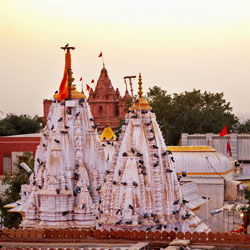
About Bhandeshwar Jain Temples, Bikaner History The Bhandeshwar Jain Temples in Bikaner are a group of beautifully crafted temples that date back to the 15th century. These temples were built during the rule of Maharaja Rai Singh, the sixth ruler of Bikaner. The intricate carvings and stunning architecture of the temples speak to the rich cultural and religious history of the region. Architecture and Design The Bhandeshwar Jain Temples are known for their exquisite architecture and design. The temples are made of red sandstone and feature intricate carvings, delicate sculptures, and elaborate lattice work. The interiors of the temples are adorned with beautiful paintings and frescoes that depict Jain teachings and mythology. Best Time to Visit While the Bhandeshwar Jain Temples can be visited throughout the year, the best time to visit is during the winter months from October to March when the weather is pleasant and cool. Cultural Significance The Bhandeshwar Jain Temples hold immense cultural significance for the Jain community as they are considered sacred places of worship. The temples are also significant for their historical importance and architectural beauty, attracting visitors from all over the world. Pilgrimage Practices Visitors to the Bhandeshwar Jain Temples can participate in various pilgrimage practices such as offering prayers, meditating, and performing rituals. Pilgrims often undertake a journey to the temples to seek spiritual enlightenment and blessings. Dress Code and Etiquette While visiting the Bhandeshwar Jain Temples, it is important to dress modestly and respectfully. Visitors should cover their shoulders and knees and remove their shoes before entering the temple premises. Silence and reverence should be maintained inside the temples to show respect for the religious practices. Activities and Experiences Visitors to the Bhandeshwar Jain Temples can engage in various activities and experiences such as attending religious ceremonies, exploring the intricate architecture, and learning about Jain teachings. The serene atmosphere of the temples provides a peaceful and reflective space for visitors. Art and Religious Symbols The Bhandeshwar Jain Temples are adorned with exquisite art and religious symbols that hold deep significance for the Jain community. The intricate carvings, paintings, and sculptures depict scenes from Jain mythology and teachings, creating a spiritual and aesthetic experience for visitors. Local Insights Local residents and guides at the Bhandeshwar Jain Temples can provide valuable insights into the history, architecture, and cultural significance of the temples. Visitors can learn about the traditions and practices of the Jain community and gain a deeper understanding of the spiritual heritage of the region.
Explore More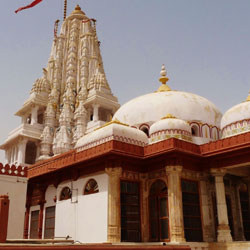
About Jain Temple Bhandasar, Bikaner History Jain Temple Bhandasar in Bikaner is a sacred place of worship for the Jain community. It was built by a wealthy merchant named Bhandasa Oswal in the 15th century. The construction of the temple took 45 years to complete, as it was meticulously designed and crafted with intricate marble carvings and vibrant frescoes. Architecture and Design The Jain Temple Bhandasar is renowned for its stunning architectural beauty. The temple is adorned with intricately carved marble columns, delicate filigree work, and colorful frescoes depicting Jain legends and stories. The temple's architecture is a perfect blend of Rajput and Mughal styles, making it a unique and visually stunning masterpiece. Best Time to Visit Winter months from October to March are the best time to visit Jain Temple Bhandasar in Bikaner, as the weather is pleasant and ideal for sightseeing. Cultural Significance The Jain Temple Bhandasar holds great cultural significance for the Jain community, as it is dedicated to the 5th Jain Tirthankara, Sumatinath. The temple is a symbol of Jain ideals such as non-violence, truth, and compassion. Pilgrimage Practices Pilgrims visiting the Jain Temple Bhandasar often perform rituals and prayers to seek blessings and spiritual enlightenment. Many followers also engage in meditation and reflection within the serene confines of the temple. Dress Code and Etiquette Visitors are required to dress modestly and cover their shoulders and legs while visiting the Jain Temple Bhandasar. It is customary to remove your shoes before entering the temple premises. Respectful behavior and silence are encouraged to maintain the sanctity of the temple. Activities and Experiences Visitors to Jain Temple Bhandasar can partake in various activities and experiences, such as exploring the exquisite architecture, admiring the intricate marble carvings, and soaking in the spiritual ambiance of the temple. Art and Religious Symbols The Jain Temple Bhandasar is adorned with beautiful artwork and religious symbols that symbolize Jain teachings and beliefs. Visitors can marvel at the detailed frescoes depicting Jain deities, Tirthankaras, and celestial beings. Local Insights Local guides at the Jain Temple Bhandasar can provide valuable insights into the history, architecture, and spiritual significance of the temple. Visitors can also learn about Jain customs, traditions, and rituals from the knowledgeable locals.
Explore More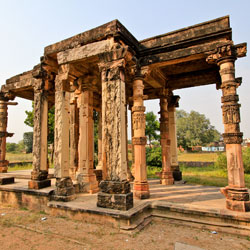
About Ghantai Temple, Khajuraho History The Ghantai Temple is located in Khajuraho, a UNESCO World Heritage Site known for its beautiful temples. The temple was built in the 10th century by the Chandela dynasty, dedicated to the Jain religion. It is named after the bells (ghanta) that adorn the outer walls of the temple. Architecture and Design The Ghantai Temple showcases intricate carvings and sculptures that depict various Jain deities and celestial beings. The temple's architecture follows the traditional Nagara style with a shikara (spire) and mandapa (pillared hall). The outer walls are adorned with images of tirthankaras (spiritual teachers) and scenes from Jain mythology. Best Time to Visit Visit during the winter months from October to March for pleasant weather. Avoid the monsoon season from July to September due to heavy rainfall. Plan your visit early in the morning or late in the evening to avoid the crowds. Cultural Significance The Ghantai Temple is an important pilgrimage site for Jains, attracting devotees from around the world. It symbolizes peace, harmony, and spiritual enlightenment, making it a sacred place for meditation and prayer. Pilgrimage Practices Visitors to the Ghantai Temple are encouraged to observe silence, respect the sanctity of the temple, and participate in rituals such as offering prayers and lighting incense. Pilgrims often perform parikrama (circumambulation) around the temple as a form of devotion. Dress Code and Etiquette Visitors are expected to dress modestly when visiting the Ghantai Temple, covering their shoulders and knees. Shoes are not allowed inside the temple premises, so it is recommended to wear comfortable footwear that can easily be removed before entering. Activities and Experiences Visitors can explore the intricate carvings and sculptures of the Ghantai Temple, learn about Jain mythology and teachings, and participate in meditation and prayer sessions. Guided tours are also available for those interested in learning more about the history and significance of the temple. Art and Religious Symbols The Ghantai Temple features stunning artwork that showcases the creativity and craftsmanship of the Chandela artisans. The temple's sculptures and carvings depict various Jain deities, symbols, and mythological stories, reflecting the spiritual beliefs and practices of the Jain community. Local Insights Local guides and historians can provide valuable insights into the history, architecture, and significance of the Ghantai Temple. They can share stories and anecdotes that offer a deeper understanding of the temple's cultural and religious significance, making your visit a truly enriching experience.
Explore More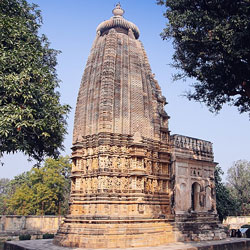
About Adinath Temple, Khajuraho History The Adinath Temple in Khajuraho, India is a significant Jain temple that dates back to the 11th century. It was built during the Chandela dynasty and is dedicated to the Jain Tirthankara, Adinath. The temple complex is known for its intricate carvings and stunning architecture, which showcases the skill and craftsmanship of the artisans of that era. Architecture and Design The Adinath Temple is a fine example of Nagara style architecture, characterized by its tall spires. The temple is adorned with elaborate sculptures of Jain deities, celestial beings, and mythological creatures. The intricate carvings on the walls depict scenes from Jain mythology and everyday life. The temple's sanctum sanctorum houses the idol of Adinath, which is worshipped by devotees. Best Time to Visit - The best time to visit the Adinath Temple is during the winter months from November to February when the weather is pleasant. - It is recommended to visit early in the morning or late in the evening to avoid the heat of the day. - Plan your visit during the Khajuraho Dance Festival held in February, where you can witness traditional Indian dance performances against the backdrop of the illuminated temples. Cultural Significance The Adinath Temple holds immense cultural significance for the Jain community as a place of worship and pilgrimage. It is a symbol of Jain architecture and religious heritage, reflecting the values and beliefs of the Jain faith through its art and design. Pilgrimage Practices Devotees visiting the Adinath Temple engage in various religious practices such as offering prayers, performing rituals, and seeking blessings from the deity. Some pilgrims also undertake fasting and meditation as a form of spiritual discipline during their visit to the temple. Dress Code and Etiquette Visitors to the Adinath Temple are required to dress modestly and respectfully. It is advisable to wear appropriate attire that covers the shoulders and knees. Removing footwear before entering the temple premises is a common practice to show reverence to the sacred space. Silence and decorum are also expected inside the temple to maintain the sanctity of the place of worship. Activities and Experiences While at the Adinath Temple, visitors can participate in various activities such as attending religious ceremonies, exploring the temple complex, and admiring the intricate carvings and sculptures. Additionally, visitors can engage in meditation and prayer to experience a sense of spiritual tranquility in the serene ambiance of the temple. Art and Religious Symbols The Adinath Temple is adorned with exquisite artwork and religious symbols that depict Jain cosmology and spiritual philosophy. The intricate carvings on the temple walls showcase scenes from Jain mythology, the life of Adinath, and the principles of non-violence, truth, and compassion that are central to Jainism. Local Insights Local guides and historians can provide valuable insights into the history, architecture, and cultural significance of the Adinath Temple. They can offer a deeper understanding of the symbolism and significance of the sculptures and carvings, as well as share fascinating stories and anecdotes related to the temple and its place in Jain heritage.
Explore More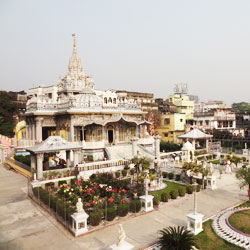
About Pareshnath Jain Temple, Kolkata The Pareshnath Jain Temple is a popular religious site located in the city of Kolkata, West Bengal. It is dedicated to the Jain community and is known for its intricate architecture and serene ambiance. The temple attracts devotees and tourists alike from all over the country who come to seek blessings and marvel at the beauty of the temple. History The Pareshnath Jain Temple was built in the late 19th century by a group of Jain merchants who settled in Kolkata. The temple was dedicated to the 10th Jain Tirthankara, Shri Sital Nath Ji. Over the years, the temple has undergone several renovations and expansions, but its original charm and spiritual significance have remained intact. Architecture and Design The Pareshnath Jain Temple features a blend of traditional Jain architecture with modern design elements. The temple is adorned with intricate carvings, colorful murals, and marble statues. The main sanctum sanctorum houses the idol of Lord Sital Nath Ji, and the entire temple complex exudes a sense of peace and tranquility. Best Time to Visit Visiting the Pareshnath Jain Temple is ideal during the winter months (October to March) when the weather is pleasant and conducive for exploring the temple premises. The temple is open throughout the year, but it is advisable to avoid visiting during monsoon season due to heavy rainfall. Cultural Significance The Pareshnath Jain Temple holds great cultural significance for the Jain community in Kolkata. It is a place of worship, meditation, and spiritual learning for followers of Jainism. The temple also serves as a venue for religious festivals, rituals, and community gatherings. Pilgrimage Practices Devotees visiting the Pareshnath Jain Temple often engage in traditional practices such as offering prayers, performing rituals, and seeking blessings from the deity. Pilgrims may also participate in religious discourses, bhajans, and meditation sessions conducted at the temple premises. Dress Code and Etiquette Visitors to the Pareshnath Jain Temple are required to dress modestly and remove their footwear before entering the temple premises. Additionally, it is important to maintain silence and respect the sanctity of the temple. Photography and videography may be restricted in certain areas of the temple. Activities and Experiences Some of the activities and experiences that visitors can enjoy at the Pareshnath Jain Temple include attending religious ceremonies, exploring the temple complex, and interacting with the resident priests. The temple also hosts cultural programs, lectures, and workshops on Jain philosophy and spirituality. Art and Religious Symbols The Pareshnath Jain Temple is known for its exquisite artistry and religious symbolism. The temple walls are adorned with intricate paintings depicting scenes from Jain mythology and teachings. Symbolic representations of Jain deities, Tirthankaras, and sacred symbols can be found throughout the temple. Local Insights For a deeper understanding of the history and significance of the Pareshnath Jain Temple, visitors can interact with the local Jain community members and temple authorities. They can provide insights into the customs, traditions, and practices followed at the temple, as well as offer guidance on exploring the spiritual aspects of Jainism.
Explore More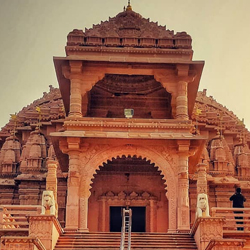
Shantinath Digambar Jain Temple
About Shantinath Digambar Jain Temple, Nagpur Shantinath Digambar Jain Temple, located in Nagpur, is a significant religious site for the Jain community. Dedicated to Lord Shantinath, the temple is renowned for its stunning architecture and serene ambiance. History, Architecture, and Design The Shantinath Digambar Jain Temple was built in the early 20th century and showcases traditional Jain architecture. The temple's intricate carvings, marble pillars, and colorful domes are a sight to behold. Its peaceful surroundings and ornate design make it a must-visit for architecture enthusiasts and spiritual seekers alike. Best Time to Visit The temple is open throughout the year, but the best time to visit is during the Jain festivals such as Mahavir Jayanti or Paryushan Parva. Avoid visiting during peak hours to experience a more peaceful and tranquil atmosphere. Cultural Significance The Shantinath Digambar Jain Temple holds great cultural significance for the Jain community. It is a place of worship and reflection, where devotees come to seek blessings, offer prayers, and engage in spiritual practices. Pilgrimage Practices Devotees visiting the temple often engage in traditional Jain practices such as meditation, prayers, and offerings. It is believed that by following these practices, one can attain spiritual enlightenment and inner peace. Dress Code and Etiquette Visitors to the Shantinath Digambar Jain Temple are expected to dress modestly and respectfully. It is customary to remove footwear before entering the temple premises and maintain a quiet and reverent demeanor while inside. Activities and Experiences Some of the activities and experiences that visitors can enjoy at the temple include participating in religious ceremonies, attending lectures on Jain philosophy, and exploring the temple's beautiful surroundings. The tranquil atmosphere and spiritual energy of the temple make it an ideal place for introspection and meditation. Art and Religious Symbols The Shantinath Digambar Jain Temple is adorned with intricate artwork and religious symbols that hold deep significance for the Jain community. The temple's walls are adorned with colorful paintings depicting scenes from Jain mythology and teachings, while its architecture is a testament to the rich heritage and spiritual beliefs of the Jain faith. Local Insights Visitors to the Shantinath Digambar Jain Temple can gain insights into the local Jain community's customs, traditions, and way of life. Interacting with local devotees and participating in temple activities can provide a deeper understanding of Jain culture and spirituality.
Explore More
About Mahavir Mandir, Patna History The Mahavir Mandir in Patna, Bihar, is a renowned Hindu temple dedicated to Lord Hanuman. It was founded in the early 20th century by Swami Balananda, a saint and philanthropist. The temple has since become a significant religious and cultural landmark in the region, attracting thousands of devotees every year. Architecture and Design The Mahavir Mandir boasts a striking architectural design, with intricate carvings, colorful paintings, and a towering spire that reaches towards the sky. The temple complex is spread over a large area, with various shrines, prayer halls, and pavilions for worshippers to explore. The overall ambiance of the temple is one of peace, serenity, and devotion. Best Time to Visit - The best time to visit Mahavir Mandir is during the Hindu festival of Hanuman Jayanti, which falls in the month of Chaitra (March-April). - Another ideal time to visit is during the festival of Diwali, when the temple is beautifully decorated with lights and flowers. Cultural Significance The Mahavir Mandir holds immense cultural significance for the people of Bihar and beyond. It is believed that worshipping at this temple can bestow blessings of strength, courage, and protection from evil forces. The temple also serves as a hub for various religious and cultural events throughout the year, bringing communities together in celebration and prayer. Pilgrimage Practices Devotees visiting the Mahavir Mandir are encouraged to perform various rituals and practices to show their devotion to Lord Hanuman. This may include offering prayers, lighting incense sticks, and making offerings of flowers and fruits. Many pilgrims also participate in group chanting of Hanuman Chalisa, a sacred hymn dedicated to Lord Hanuman. Dress Code and Etiquette While there is no strict dress code enforced at the Mahavir Mandir, visitors are encouraged to dress modestly and respectfully. It is customary to remove shoes before entering the temple premises and to maintain a quiet and reverent demeanor while inside. Taking photographs or video recordings may be restricted in certain areas of the temple. Activities and Experiences Visitors to the Mahavir Mandir can engage in a variety of activities to enhance their spiritual experience. This may include attending daily prayer ceremonies, participating in guided tours of the temple complex, and seeking blessings from the resident priests. The temple also hosts cultural programs, religious discourses, and philanthropic initiatives for the benefit of the community. Art and Religious Symbols The Mahavir Mandir is adorned with exquisite artwork and religious symbols that pay homage to Lord Hanuman and other deities. Intricate carvings, vibrant paintings, and ornate sculptures can be found throughout the temple, depicting scenes from Hindu mythology and teachings. The presence of these artistic elements adds to the spiritual ambiance of the temple. Local Insights Visiting the Mahavir Mandir offers a unique opportunity to immerse oneself in the local culture and customs of Patna. Interacting with the temple staff, participating in religious ceremonies, and exploring nearby markets and eateries can provide valuable insights into the daily life of the residents. Many locals are eager to share their knowledge and experiences with visitors, creating a welcoming and enriching environment for all.
Explore More
About Jainath Temple The Jainath Temple, located in Adilabad, is a significant religious site for the Jain community in India. It is a place of worship and pilgrimage for followers of Jainism, a religion that emphasizes non-violence and spiritual enlightenment. The temple is known for its intricate architecture, rich history, and cultural significance. History, Architecture and Design The Jainath Temple dates back to ancient times and is believed to have been built during the 10th century. The temple is dedicated to Lord Adinath, the first Tirthankara of Jainism. The architecture of the temple is a blend of Dravidian and Nagara styles, with intricate carvings and sculptures depicting Jain deities and symbols. The temple is adorned with colorful frescoes and intricate stone carvings, showcasing the craftsmanship and artistic skill of the artisans who built it. Best Time to Visit 1. The best time to visit the Jainath Temple is during the winter months, from October to February, when the weather is pleasant and cool. 2. Avoid visiting during the summer months, as temperatures can soar and make it uncomfortable for outdoor activities. 3. The temple is particularly crowded during Jain festivals and auspicious days, so plan your visit accordingly to experience the vibrant cultural celebrations. Cultural Significance The Jainath Temple is considered a sacred site for the Jain community, who come here to pray, meditate, and seek spiritual guidance. The temple is also a symbol of Jain heritage and tradition, preserving the teachings and ideals of Jainism for future generations. The temple's architecture and design reflect the rich cultural heritage of Jainism, making it a significant cultural landmark in Adilabad. Pilgrimage Practices Visitors to the Jainath Temple are encouraged to participate in traditional pilgrimage practices, such as offering prayers, performing rituals, and seeking blessings from the deities. Pilgrims often walk barefoot around the temple premises as a sign of humility and devotion. Many visitors also participate in meditation and yoga sessions to deepen their spiritual connection with the divine. Dress Code and Etiquette When visiting the Jainath Temple, it is important to dress modestly and respectfully, covering your shoulders and knees. Remove your shoes before entering the temple premises as a sign of respect for the sacred space. Visitors are expected to maintain silence and refrain from engaging in loud or disruptive behavior inside the temple. Photography and videography may be restricted, so be sure to follow the guidelines set by the temple authorities. Activities and Experiences Visitors to the Jainath Temple can participate in a variety of activities and experiences to enhance their spiritual journey. Attend religious ceremonies and rituals, listen to spiritual discourses, and interact with the temple priests to gain insights into Jain philosophy and practices. Take a guided tour of the temple complex to learn about its history and significance, or simply sit in quiet contemplation in the peaceful surroundings of the temple. Art and Religious Symbols The Jainath Temple is adorned with intricate stone carvings, colorful frescoes, and beautiful sculptures depicting Jain deities, symbols, and mythological scenes. The temple's architecture and design are a testament to the artistic skill and craftsmanship of the artisans who built it. Visitors can admire the intricate details of the temple's artwork and learn about the religious symbolism behind each carving and sculpture. Local Insights When visiting the Jainath Temple, take the time to explore the surrounding area and interact with the local community. Sample traditional Jain cuisine at nearby eateries, shop for handicrafts and souvenirs at local markets, and immerse yourself in the rich cultural heritage of Adilabad. Talk to the locals to gain insights into the history and significance of the temple, and learn about the customs and traditions of the Jain community in the region.
Explore More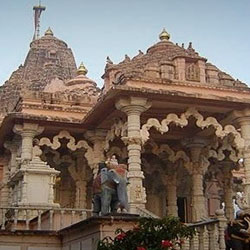
About Hinkar Thirtha, Vijayawada Hinkar Thirtha is a renowned pilgrimage site located in Vijayawada, Andhra Pradesh. It holds great religious significance for devotees and visitors alike. The temple is dedicated to Lord Shiva and is known for its beautiful architecture and serene atmosphere. History The history of Hinkar Thirtha dates back centuries, with references to the temple found in ancient texts and scriptures. It is believed to have been built during the rule of the Chalukya dynasty and has since been a place of worship and spiritual solace for countless devotees. Architecture and Design The temple boasts impressive architecture and design, featuring intricate carvings, majestic pillars, and stunning sculptures of various Hindu deities. The main shrine is adorned with intricate artwork, creating a peaceful and sacred ambiance for visitors. Best Time to Visit Visiting Hinkar Thirtha can be a wonderful experience at any time of the year. However, the best time to visit is during the winter months, from November to February, when the weather is cool and pleasant. Cultural Significance Hinkar Thirtha holds immense cultural significance as a place of worship and spiritual healing. It is believed that prayers offered at the temple bring peace, prosperity, and blessings to devotees. Pilgrimage Practices Devotees visiting Hinkar Thirtha often engage in various pilgrimage practices such as offering prayers, performing rituals, and seeking blessings from the deity. Many also participate in special events and ceremonies held at the temple. Dress Code and Etiquette While visiting Hinkar Thirtha, it is important to dress modestly and respectfully. Both men and women are advised to wear traditional attire and avoid revealing clothing. Visitors are also expected to maintain silence and show reverence towards the deity. Activities and Experiences Visitors to Hinkar Thirtha can partake in a range of activities and experiences. These include attending puja ceremonies, exploring the temple complex, meditating in the peaceful surroundings, and participating in cultural events and festivals. Art and Religious Symbols The temple is adorned with exquisite artwork and religious symbols that depict various aspects of Hindu mythology and spirituality. Intricate carvings, colorful paintings, and sacred symbols can be seen throughout the temple complex, adding to its beauty and significance. Local Insights Local residents and priests at Hinkar Thirtha offer valuable insights into the temple's history, traditions, and spiritual practices. Visitors can engage with them to learn more about the significance of the temple and its role in the local community.
Explore More
About Mombasa Jain Temple The Mombasa Jain Temple, located in Mombasa, Kenya, is a beautiful and historically significant religious site for the Jain community. The temple is known for its stunning architecture, intricate design, and cultural significance. History, Architecture, and Design The Mombasa Jain Temple was built in the early 20th century by the Jain community in Mombasa. The temple showcases a unique blend of traditional Jain architecture with influences from East African styles. The intricate carvings, colorful paintings, and ornate decorations make the temple a true marvel to behold. Best Time to Visit - The best time to visit the Mombasa Jain Temple is during the winter months (June to August) when the weather is cooler and more pleasant. - It's also recommended to visit during Jain festivals and special events to experience the temple at its most vibrant and lively. Cultural Significance The Mombasa Jain Temple holds great cultural significance for the Jain community in Kenya. It serves as a place of worship, community gatherings, and cultural celebrations for Jains living in Mombasa and its surrounding regions. Pilgrimage Practices Visitors to the Mombasa Jain Temple can participate in traditional Jain rituals and practices, such as prayer ceremonies, meditation sessions, and offerings to the deities. Pilgrims often visit the temple to seek blessings, guidance, and spiritual fulfillment. Dress Code and Etiquette Visitors to the Mombasa Jain Temple are required to dress modestly and respectfully. It is recommended to wear conservative clothing that covers the shoulders, knees, and chest. Shoes are typically removed before entering the temple premises, and guests are expected to maintain a quiet and reverent demeanor while inside the temple. Activities and Experiences Visitors to the Mombasa Jain Temple can engage in a variety of activities and experiences, including exploring the temple grounds, attending religious ceremonies, participating in cultural events, and learning about Jainism from knowledgeable guides and priests. Art and Religious Symbols The Mombasa Jain Temple is adorned with exquisite artwork and religious symbols that reflect the rich symbolism and spiritual beliefs of Jainism. The temple's architecture, sculptures, paintings, and decorations all serve as visual representations of Jain teachings and philosophies. Local Insights Visitors to the Mombasa Jain Temple can gain valuable insights into the history, culture, and traditions of the Jain community in Kenya. By interacting with local Jains, attending cultural events, and exploring the temple's architecture and design, visitors can deepen their understanding and appreciation of Jainism and its place in Kenyan society.
Explore More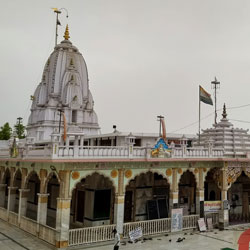
About Tijara Jain Temple History The Tijara Jain Temple, located in Alwar, is a significant pilgrimage site for the Jain community. The temple dates back to the 8th century and is dedicated to Lord Mahavira, the 24th Tirthankara of Jainism. It serves as a place of worship, reflection, and spiritual growth for followers of the Jain faith. Architecture and Design The Tijara Jain Temple is renowned for its stunning architecture and intricate design. The temple features exquisite carvings, ornate pillars, and beautiful sculptures that showcase the craftsmanship and artistry of ancient Jain architects. The temple's walls are adorned with colorful frescoes depicting scenes from Jain mythology, creating a serene and sacred atmosphere for visitors. Best Time to Visit The best time to visit the Tijara Jain Temple is during the winter months, from October to March, when the weather is pleasant and suitable for exploring the temple complex. Avoid visiting during the summer months, as temperatures can soar in Alwar, making it uncomfortable to roam around the temple. Cultural Significance The Tijara Jain Temple holds immense cultural significance for the Jain community, as it serves as a place of worship, meditation, and spiritual enlightenment. The temple is a symbol of Jain heritage and tradition, and its preservation is crucial for maintaining the rich cultural legacy of Jainism. Pilgrimage Practices Visitors are required to remove their shoes before entering the temple premises as a sign of respect. Pilgrims often perform rituals such as offering prayers, lighting incense sticks, and making offerings of flowers and fruits to Lord Mahavira. The temple complex also includes meditation halls and prayer rooms where devotees can engage in spiritual practices and seek inner peace. Dress Code and Etiquette Visitors are expected to dress modestly and appropriately when visiting the temple, covering their shoulders and knees out of respect for the sacredness of the site. Refrain from taking photographs inside the temple premises, as it is considered disrespectful to the sanctity of the place. Observe silence and maintain a calm and respectful demeanor while inside the temple to avoid disturbing others who are engaged in prayer and meditation. Activities and Experiences Visitors to the Tijara Jain Temple can participate in a variety of activities and experiences that enhance their spiritual journey and cultural understanding. Some of the activities include attending religious ceremonies, exploring the temple complex, interacting with Jain monks, and learning about Jain teachings and philosophy. Art and Religious Symbols The Tijara Jain Temple is adorned with intricate artwork, including intricate carvings, colorful frescoes, and symbolic sculptures that depict Jain deities, teachings, and stories. The temple's architecture is a blend of artistic creativity and spiritual symbolism, creating a visually stunning and spiritually uplifting environment for visitors. Local Insights Visiting the Tijara Jain Temple offers a unique opportunity to gain insights into Jain culture, traditions, and beliefs. Interacting with local devotees, attending religious ceremonies, and exploring the temple's architecture provide a deeper understanding of Jainism and its significance in the local community. Engaging with the local community allows visitors to appreciate the cultural richness and spiritual depth of Jain heritage in Alwar.
Explore More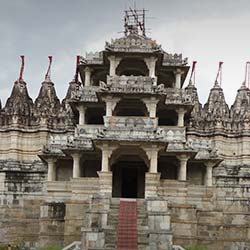
About the Mount Abu Jain Temples The Mount Abu Jain Temples are a group of ancient temples located in the picturesque hill station of Mount Abu in Rajasthan, India. These temples hold great cultural and religious significance for the Jain community and attract devotees and tourists from all over the world. The temples are known for their stunning architecture, intricate carvings, and serene surroundings, making them a must-visit destination for anyone interested in spirituality and history. History, Architecture, and Design The Mount Abu Jain Temples have a rich history dating back to the 11th century when they were built by the Parmar dynasty. The temples showcase a unique blend of Rajput and Jain architectural styles, with intricate marble carvings, domes, and pillars adorning the structures. The temples are dedicated to various Jain Tirthankaras and feature beautiful idols and sculptures that are a testament to the craftsmanship of the artisans of that time. Best Time to Visit - The best time to visit the Mount Abu Jain Temples is during the winter months from October to March when the weather is pleasant and conducive for exploring the temples and surrounding areas. - Avoid visiting during the monsoon season, from July to September, as the region experiences heavy rainfall and the temples may be slippery and inaccessible. Cultural Significance The Mount Abu Jain Temples hold immense cultural significance for the Jain community as they are considered sacred places of worship and pilgrimage. The temples are also important from a historical perspective as they showcase the rich heritage and architectural prowess of the region. Pilgrimage Practices Devotees visiting the Mount Abu Jain Temples engage in various pilgrimage practices such as offering prayers, performing rituals, and participating in religious ceremonies. The temples are considered a place of spiritual rejuvenation and enlightenment, and pilgrims often spend hours meditating and seeking blessings from the deities. Dress Code and Etiquette Visitors to the Mount Abu Jain Temples are required to dress modestly and adhere to the customs and traditions of the Jain community. It is recommended to wear conservative clothing that covers the shoulders and knees, remove shoes before entering the temples, and maintain a respectful demeanor while inside the sacred premises. Activities and Experiences While visiting the Mount Abu Jain Temples, visitors can partake in a variety of activities and experiences such as attending religious ceremonies, exploring the intricate carvings and sculptures, and soaking in the peaceful ambience of the temples. Additionally, visitors can also explore the surrounding areas of Mount Abu and indulge in nature walks and sightseeing. Art and Religious Symbols The Mount Abu Jain Temples are adorned with exquisite art and religious symbols that depict the teachings and principles of Jainism. The temples feature intricate carvings of Tirthankaras, Jain deities, and celestial beings, as well as symbols such as the swastika and lotus that hold deep spiritual significance in Jain culture. Local Insights Visitors to the Mount Abu Jain Temples can gain valuable insights into the local culture and traditions of the Jain community by interacting with the priests, attending religious discourses, and observing the daily rituals and practices followed at the temples. Local guides are also available to provide in-depth knowledge about the history and significance of the temples.
Explore More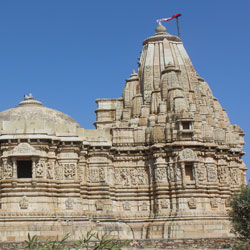
About Jain Temple, Chittorgarh History The Jain Temple in Chittorgarh has a rich history dating back to centuries. It is believed to have been built during the 11th century by the Solanki dynasty. The temple has witnessed various renovations and additions over the years, making it a significant historical and architectural landmark in the region. Architecture and Design The Jain Temple in Chittorgarh showcases exquisite architecture and intricate design elements. The temple features stunning sculptures, detailed carvings, and beautiful idols of Jain Tirthankaras. The structure reflects a blend of traditional Rajput and Jain architectural styles, making it a visually appealing sight for visitors. Best Time to Visit - The best time to visit Jain Temple, Chittorgarh is during the winter months from October to March when the weather is pleasant and ideal for sightseeing. - It is recommended to avoid visiting during the summer months from April to June as the temperatures can be extremely hot and uncomfortable. Cultural Significance The Jain Temple holds immense cultural significance for the Jain community and locals in Chittorgarh. It serves as a sacred place of worship and pilgrimage, attracting devotees from far and wide to seek blessings and spiritual solace. Pilgrimage Practices Devotees visiting the Jain Temple in Chittorgarh often engage in various pilgrimage practices such as offering prayers, performing rituals, and participating in religious ceremonies. It is a place where believers come to connect with their faith and deepen their spiritual bond with the divine. Dress Code and Etiquette Visitors are advised to dress modestly and respect the religious sanctity of the Jain Temple. It is customary to remove shoes before entering the temple premises and maintain a quiet and reverent demeanor while inside. Taking photographs or video recordings may be restricted, so it is essential to adhere to the guidelines and show reverence towards the sacred space. Activities and Experiences Visitors to the Jain Temple can indulge in a variety of activities and experiences to enhance their spiritual journey. They can participate in guided tours, attend religious ceremonies, explore the temple complex, and interact with local devotees to gain insights into Jain traditions and customs. Art and Religious Symbols The Jain Temple in Chittorgarh is adorned with exquisite artistry and religious symbols that hold deep spiritual significance for followers of Jainism. From intricate sculptures of Tirthankaras to symbolic motifs and depictions of Jain mythology, the temple serves as a visual feast for art enthusiasts and religious devotees alike. Local Insights Visiting the Jain Temple in Chittorgarh offers travelers a unique opportunity to immerse themselves in the local culture and traditions of the region. Interacting with local residents, exploring nearby markets, and tasting traditional cuisine can provide valuable insights into the vibrant heritage and lifestyle of the people in Chittorgarh.
Explore More
About Digambar Jain Mandir, Bhagalpur History The Digambar Jain Mandir in Bhagalpur is a significant place of worship for the Jain community. It was established several centuries ago and has since been a center of spirituality and religious practices for followers of Jainism in the region. The temple has undergone numerous renovations and expansions over the years, making it a blend of ancient and modern architectural styles. Architecture and Design The temple boasts a stunning architectural design that is a testament to the skilled craftsmanship of its builders. The intricate carvings, majestic domes, and vibrant colors of the temple's facade make it a sight to behold. The interior of the temple is adorned with ornate sculptures and paintings that depict stories from Jain mythology. Best Time to Visit 1. The best time to visit the Digambar Jain Mandir is during the months of October to March when the weather is pleasant. 2. Avoid visiting during the monsoon season as the roads leading to the temple may be slippery and dangerous. Cultural Significance The Digambar Jain Mandir holds immense cultural significance as it is a place where followers of Jainism come to seek spiritual guidance and perform religious rituals. The temple is also a hub of cultural activities and festivals that celebrate the teachings of Lord Mahavira. Pilgrimage Practices Visitors to the Digambar Jain Mandir are encouraged to participate in the various religious practices and rituals that take place within the temple premises. These practices include meditation, chanting of Jain mantras, and offering prayers to the deities. Dress Code and Etiquette Visitors are expected to dress modestly when visiting the Digambar Jain Mandir. It is advisable to wear clothes that cover the shoulders and knees out of respect for the religious traditions of the temple. Additionally, visitors are required to remove their shoes before entering the temple premises. Activities and Experiences Visitors to the Digambar Jain Mandir can take part in a variety of activities and experiences that are designed to enhance their spiritual journey. These include attending religious discourses, participating in puja ceremonies, and exploring the temple's beautiful gardens and surroundings. Art and Religious Symbols The temple is adorned with intricate sculptures and paintings that depict scenes from Jain mythology. Visitors can admire the exquisite artwork and learn more about the religious symbols and motifs that are significant to the Jain faith. Local Insights Visitors to the Digambar Jain Mandir can gain valuable insights into the local Jain community's customs and traditions. They can interact with the temple's priests and devotees, learn about the history and significance of the temple, and immerse themselves in the rich cultural heritage of Bhagalpur.
Explore More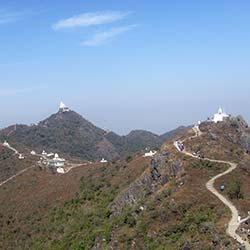
About Parasnath Hills – Bokaro Parasnath Hills in Bokaro, Jharkhand, are a sacred place for the Jain community and a popular pilgrimage site. The hills are named after Parshvanatha, the 23rd Tirthankara of Jainism, who is believed to have attained enlightenment here. The site is known for its natural beauty, tranquil atmosphere, and spiritual significance. History, Architecture, and Design Parasnath Hills have a rich history dating back to ancient times. The temples and shrines on the hills are renowned for their intricate architecture and design, reflecting the Jain beliefs and traditions. The place is a perfect blend of natural beauty and human craftsmanship. Best Time to Visit 1. The best time to visit Parasnath Hills is during the winter months from November to February when the weather is pleasant. 2. Avoid visiting during the monsoon season as the hills can get slippery and dangerous. 3. Early mornings and late evenings are ideal for a peaceful visit to witness the sunrise or sunset. Cultural Significance Parasnath Hills hold immense cultural significance for the Jain community as a sacred pilgrimage site associated with the Tirthankara Parshvanatha. The place is a symbol of spiritual enlightenment and inner peace for devotees. Pilgrimage Practices Devotees often undertake a pilgrimage to Parasnath Hills to seek blessings, meditate, and perform rituals. The climb to the hilltop is considered an act of devotion and penance, with many pilgrims chanting prayers along the way. Dress Code and Etiquette Visitors are expected to dress modestly and respectfully while visiting Parasnath Hills. Wearing traditional attire or white clothing is encouraged as a mark of reverence. Maintaining silence and cleanliness is essential to uphold the sanctity of the place. Activities and Experiences 1. Trekking: Embark on a trek to the hilltop for a rewarding experience and panoramic views of the surrounding landscape. 2. Meditation: Find inner peace and tranquility by meditating at the temples and shrines on the hills. 3. Photography: Capture the scenic beauty and spiritual essence of Parasnath Hills through photography. 4. Cultural Programs: Attend religious ceremonies and cultural events organized at the site. Art and Religious Symbols The temples and shrines on Parasnath Hills are adorned with intricate carvings, sculptures, and religious symbols that reflect the Jain faith and mythology. The artistry and symbolism of these structures are a testament to the devotion and craftsmanship of the Jain community. Local Insights 1. Local Cuisine: Enjoy traditional Jain cuisine and local delicacies at nearby eateries. 2. Shopping: Purchase souvenirs, religious items, and handicrafts from local shops. 3. Festivals: Participate in Jain festivals and celebrations to experience the vibrant culture of the community. Overall, Parasnath Hills in Bokaro offer a unique blend of natural beauty, spirituality, and cultural heritage, making it a must-visit destination for pilgrims, tourists, and nature enthusiasts alike.
Explore More
About Shikharji Dham, Bokaro Shikharji Dham, located in Bokaro, is a sacred pilgrimage site for Jains. It is believed to be the place where Lord Mahavira, the 24th Tirthankara of Jainism, attained Nirvana. The site is surrounded by lush greenery and offers a serene and spiritual atmosphere for visitors. History, Architecture, and Design Shikharji Dham has a rich history dating back to ancient times. The architecture of the temples and shrines reflects traditional Jain design principles, with intricate carvings and sculptures depicting Jain deities and symbols. The design of the site is meant to evoke a sense of peace and tranquility, perfect for meditation and reflection. Best Time to Visit 1. The best time to visit Shikharji Dham is during the winter months, from October to March, when the weather is pleasant and cool. 2. Avoid visiting during the monsoon season, from June to September, as heavy rains can make the trek to the site difficult and dangerous. Cultural Significance Shikharji Dham holds immense cultural significance for Jains, as it is considered one of the holiest pilgrimage sites in Jainism. Many devotees visit the site to pay their respects to Lord Mahavira and seek spiritual enlightenment. Pilgrimage Practices Devotees visiting Shikharji Dham often engage in various spiritual practices such as reciting prayers, meditation, and performing rituals at the temples and shrines. Many pilgrims also undertake the arduous trek to the summit of the hill, known as Parasnath Hill, as a form of penance and devotion. Dress Code and Etiquette Visitors are expected to dress modestly and respectfully when visiting Shikharji Dham, covering their shoulders and legs. Shoes are not allowed inside the temples, so it is customary to remove them before entering. Respectful behavior and silence are also encouraged to maintain the solemn atmosphere of the site. Activities and Experiences Visitors to Shikharji Dham can participate in a range of activities such as hiking, meditation, and attending religious ceremonies. The site also offers stunning views of the surrounding landscape, making it an ideal spot for nature lovers and photography enthusiasts. Art and Religious Symbols The temples and shrines at Shikharji Dham are adorned with intricate carvings and sculptures depicting Jain deities and religious symbols. Each artwork carries deep spiritual significance and serves as a reminder of the principles and teachings of Jainism. Local Insights Local guides and residents can provide valuable insights into the history and significance of Shikharji Dham, as well as offer recommendations for nearby attractions and activities. Engaging with the local community can enhance your overall experience and deepen your understanding of the site.
Explore More
About Palitana Temple History The Palitana Temple, located in Bhavnagar, Gujarat, is considered one of the most sacred pilgrimage sites for Jains. It is believed to have been constructed in the 11th and 12th centuries. The temple complex is comprised of over 900 temples built on Mount Shatrunjaya, making it the largest Jain temple complex in the world. Architecture and Design The Palitana Temple showcases stunning architecture and intricate designs. The temples are adorned with exquisite marble carvings, detailed sculptures, and ornate domes. The temples are built in the traditional Jain architectural style, with a focus on symmetry and precision. Best Time to Visit - The best time to visit Palitana Temple is during the winter months from November to February when the weather is pleasant. - Avoid visiting during the monsoon season as the steps leading to the temple can be slippery and dangerous. Cultural Significance The Palitana Temple holds immense cultural significance for Jains as it is believed to be the place where many Tirthankaras, or spiritual teachers, achieved enlightenment. The temple complex is a symbol of spiritual purity and devotion for followers of Jainism. Pilgrimage Practices - Pilgrims visiting the Palitana Temple follow a strict code of conduct, including abstaining from consuming meat and alcohol. - Many devotees undertake the arduous task of climbing the 3,800 steps leading to the temple complex as an act of penance and devotion. Dress Code and Etiquette - Visitors to the Palitana Temple are required to dress modestly, covering their shoulders and legs. - Shoes must be removed before entering the temple complex as a sign of respect. Activities and Experiences - Climbing the 3,800 steps to reach the temple complex offers a unique and spiritual experience for visitors. - Exploring the intricately carved temples and admiring the stunning architecture is a must-do activity at Palitana Temple. Art and Religious Symbols The Palitana Temple is adorned with beautiful artwork that depicts scenes from Jain mythology and teachings. The temples also feature religious symbols such as the swastika, lotus, and om, which hold deep significance in Jainism. Local Insights - Local guides are available at Palitana Temple to provide insights into the history and significance of the temple complex. - Visitors can sample local Jain cuisine and delicacies in the nearby town of Palitana, offering a taste of the region's culinary heritage.
Explore More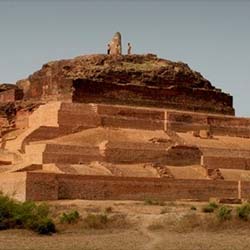
About Ahichhatra, Bareilly History Ahichhatra, located in Bareilly, Uttar Pradesh, is a historic site dating back to ancient times. It was once the capital of Northern Panchala, a region mentioned in the Mahabharata. The site has ruins of a fort, Buddhist stupas, and monasteries, dating back to the Mauryan and Kushan periods. Architecture and Design The architecture of Ahichhatra is a mix of Mauryan, Gupta, and Kushan styles. The fort ruins showcase the military architecture of the time, while the stupas and monasteries reflect the Buddhist influence in the region. Best Time to Visit Ahichhatra is best visited during the winter months, from October to March, when the weather is pleasant and ideal for exploring the archaeological site. October to March - Winter months with pleasant weather Cultural Significance Ahichhatra holds cultural significance as a historic site that dates back to ancient times. It is believed to have been a significant center for trade, religion, and politics in the region. Pilgrimage Practices Ahichhatra is not only a historic site but also a pilgrimage destination for Buddhists and followers of other religions. Pilgrims visit the stupas and monasteries to pay their respects and seek blessings. Dress Code and Etiquette Visitors to Ahichhatra are expected to dress modestly and respectfully, covering their shoulders and knees. It is also important to maintain silence and refrain from littering at the site. Activities and Experiences Visitors to Ahichhatra can explore the fort ruins, stupas, and monasteries, learning about the history and architecture of the site. Guided tours are available for a more in-depth experience. Art and Religious Symbols The stupas and monasteries at Ahichhatra are adorned with intricate carvings and religious symbols, showcasing the artistic and spiritual significance of the site. Visitors can admire the craftsmanship and symbolism in the architectural elements. Local Insights Locals in Bareilly hold Ahichhatra in high regard as a historic and religious site. They are proud of the rich heritage and cultural significance of the region, and are eager to share their knowledge and stories with visitors.
Explore More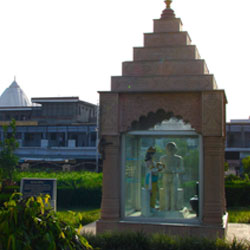
About Digambar Jain Temple, Meerut History The Digambar Jain Temple in Meerut is a significant religious site for the Jain community in India. The temple has a rich history dating back several centuries, with the exact date of its construction unknown. It is believed to have been built during the reign of the Gupta dynasty. Over the years, the temple has undergone renovations and expansions, making it a prominent place of worship for Jains in the region. Architecture and Design The Digambar Jain Temple in Meerut showcases stunning architecture and intricate design elements. The temple features beautiful carvings, intricate sculptures, and detailed artwork that reflect the rich cultural heritage of the Jain community. The temple's design incorporates traditional Jain architectural styles, with a focus on symmetry, geometry, and spiritual symbolism. Best Time to Visit - The best time to visit the Digambar Jain Temple in Meerut is during the winter months, from October to March, when the weather is pleasant. - Avoid visiting during the summer months, from April to June, as the temperatures can be quite high and uncomfortable. Cultural Significance The Digambar Jain Temple holds immense cultural significance for the Jain community, serving as a place of worship, meditation, and spiritual reflection. It is a hub for religious ceremonies, festivals, and rituals that celebrate the teachings of Jainism and promote peace, harmony, and compassion. Pilgrimage Practices When visiting the Digambar Jain Temple, pilgrims are encouraged to engage in various practices such as meditation, prayer, and offering of prayers and donations. Pilgrims also participate in religious ceremonies and rituals that are performed by Jain priests to seek blessings and guidance from the divine. Dress Code and Etiquette Visitors to the Digambar Jain Temple are expected to dress modestly and respectfully, covering their shoulders and legs. It is customary to remove shoes before entering the temple premises as a sign of respect. Visitors are also encouraged to maintain silence and refrain from taking photographs inside the temple. Activities and Experiences Visitors to the Digambar Jain Temple can participate in a range of activities and experiences, including attending religious ceremonies, listening to spiritual discourses, and exploring the temple's stunning architecture and design. The temple also offers opportunities for meditation, prayer, and reflection in a serene and peaceful setting. Art and Religious Symbols The Digambar Jain Temple is adorned with intricate artwork and religious symbols that hold deep spiritual significance for the Jain community. The temple's walls, pillars, and ceilings are decorated with symbols such as the swastika, lotus, and other auspicious motifs that represent the core beliefs and values of Jainism. Local Insights Visitors to the Digambar Jain Temple in Meerut can gain valuable insights into the Jain community's rich cultural heritage, traditions, and practices. Local guides and priests are available to provide insights into the temple's history, architecture, and religious significance, offering a deeper understanding of Jainism and its teachings.
Explore More
Shri Digambar Jain Shravasti Teerth Kshetra
Shri Digambar Jain Shravasti Teerth Kshetra, Shravasti is one of the renowned places at the land of Lucknow. There is no denying the fact that your Teerth is completed if you haven’t been to Shri Digambar Jain Shravasti Teerth Kshetra. Topping it all, all over the world the Teerth Kshetra is the best and highly acknowledged shrines of Shravasti. It is also to be noted here that Shri Digambar Jain Shravasti Teerth Kshetra is erected in the sweet memory of Lord Sambhavnath. Also, one can witness and pray in front of the white image of the presiding deity that has been constructed in the padmasana posture. It is during the time of Lord Adhishvar that the history of this beautiful place lies in. If we dig more into the historical significance of the place, then the temple is said to be the consecrated terrestrial of four Kalyanakas of Lord Sambhavnath that are birth, chayan, attainment and diksha. Ashoka and King Samprati who happen to be the great Mauryan emperor had constructed a wide number of stupas and shrines on the holy land of Shravasti. It was during that period when a number of Muslim invaders were knocked down by the Jainis in order to keep the brilliance and magnificence of the pilgrimage locations in Shravasti. Best Time to Visit: Shri Digambar Jain Shravasti Teerth Kshetra, Shravasti can be visited anytime all around the year, but the best time recommended to visit this tourist place is in the winter season for obvious reasons. Right form the month of October to February, one can hassle-free and easily enjoy exploring Shri Digambar Jain Shravasti Teerth Kshetra, Shravasti. How to Reach: For the airplane lovers, the nearest airport happens to be Chaudhary Charan International Airport which is Lucknow’s major airport and is 170 kms away from Shravasti. The devotees who are coming from Agra, Bangalore, Mumbai, Delhi, and Chennai can easily pay their holy visit by getting down at Balrampur railway station that is the nearest railway station. It will take you for over 17 kilometers drive more to reach Shravasti. Or else, if you don’t want to get down at Balrampur railway station, then Gonda railway station is 50 kms away, you can get a cab or taxi from there to reach Shri Digambar Jain Shravasti Teerth Kshetra, Shravasti. Traveller Information: To let all our readers know, Shri Digambar Jain Shravasti Teerth Kshetra is such a tourist place that is open every day right from morning to evening. So, you can visit any time the entire day. Nearby Attractions: For all those who are travelling to Shri Digambar Jain Shravasti Teerth Kshetra, Shravasti can also go through and explore the nearby attractions of the place. Angulimal Stupa, Daen Mahamongkol, Miracle Stupa, Sravasti Stupas, Sahet Mahet Fort, Kali Mata Mandir, Shiv Mandir and Sammai Mata Mandir are some of the places one can explore along with Shri Digambar Jain Shravasti Teerth Kshetra.
Explore More